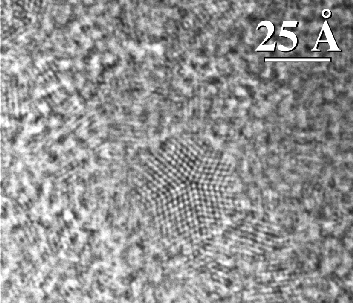by Katy Cain
Diamonds may adorn the crowns of kings and engagement rings, but they are genuinely a geologist’s best friend. Here at Carnegie Science, we use diamonds for more than their stunning sparkle. From revealing planetary formation to exploring efficient energy, here are four ways Carnegie Scientists look to diamonds to better understand our world.
1) Revealing Earth’s History Through Time and Space
Diamonds found at the surface of the Earth originate deep within the mantle, and sometimes they bring samples of the Earth’s interior along with them for the ride! These tiny mineral grains, protected in their diamond enclosures, provide geologists with a snapshot of the processes that occur deep within the Earth and billions of years in the past.
This diamond has a vivid garnet inclusion. Photo courtesy of Stephen Richardson.
These “dirty” diamonds, often considered undesirable by jewelry collectors, provide a unique glimpse at our planet’s formation, deep-Earth chemistry, and the temperature and the chemical conditions in which they were formed.
Carnegie scientist Steve Shirey focuses his research on these tiny time capsules as he works with colleagues to piece together Earth’s history. He explains, “Diamonds are important to study because they hold the deepest, oldest samples that we have that come up to the surface of the Earth.”
When analyzed, these samples can help illuminate some of the biggest mysteries about our planet. Shirey explains, “We have a tectonically active planet, and understanding how the plate tectonics process works and worked in the past is fundamental because it governs Earth’s history, a lot of our topography, the emergence of continents, and even perhaps the emergence of life.”
2) Putting the Pressure On
Diamonds show up on the Carnegie Earth and Planets campus in another big way—in diamond anvil cells (DAC).
Under pressure, materials can have some fascinating properties. For example, hydrogen turns into a liquid with metallic properties, typically inert helium forms bonds with other elements, and we can turn carbon into tunable, superconducting cages!
When it comes to applying pressure, there is truly no better tool than a diamond. Our scientists squeeze tiny samples of materials between the points of two opposing diamonds using a device called a diamond anvil cell (DAC).
This tool has been used for almost 60 years and holds the static pressure record generated in laboratories on Earth. Back in the 1970s, it was Carnegie Geophysical Lab scientists Peter M. Bell and Ho-kwang “Dave” Mao who improved on DAC designs and techniques and were able to surpass the 100GPa (1 million atmospheres of pressure) mark!
Since then, plenty of high profile research has been done at pressures exceeding 100 GPa. Nowadays, by using a beveled diamond anvil cell, researchers can generate pressures as high as 400 GPa!
3) Diamond Dust from Outer Space
Can you imagine having a piece of a star that you can study in a laboratory? While it may seem hard to fathom, that is exactly what Carnegie scientist Larry Nittler does when he looks at presolar grains.
Formed when stars go supernova and explode, presolar grains are tiny dust particles older than our Solar System itself that get trapped—and protected—inside rocks from outer space. They contain actual atoms of the stars in which they formed. By analyzing their material structure and isotopic composition, our scientists can illuminate some of the mysterious processes that occurred inside those early stars.
Larry Nittler explains the process, “We extract these grains by dissolving the meteorite away in acids, so we get rid of almost everything to find these tiny things that survive. It’s kind of like burning down a haystack to find a needle.”
Nittler continues, “It turns out one of the needles that we find are tiny diamonds, called nanodiamonds.” These nanodiamonds are insanely small, only containing a few thousand atoms per grain.

A micrograph obtained by transmission electron microscopy of some presolar diamonds. Photo courtesy T. Daulton via Larry Nittler
Because of their small size, these diamonds are very difficult to study. So, despite being one of the first presolar grains to be identified, there isn’t a lot we know about them.
Nittler has been involved in some research projects dedicated to extracting the nanodiamonds and looking at their structure with an electron microscope, revealing that what scientists thought were diamonds were actually a mix of diamond and another, far less structured, carbon phase.
Nittler continues: “These diamonds are mysterious, and they certainly have some interesting story to tell us, but we don’t know what that is yet.”
4) Diamonds from Scratch

We don’t just study diamonds or use them as a tool; we also build them!
In 2011, the U.S. Patent & Trademark Office issued a patent to the Carnegie Institution for a method of creating high-quality diamond crystals. The process creates a colorless single-crystal diamond at a rapid growth rate using chemical vapor deposition (CVD).
These lab-made diamonds have enhanced hardness and toughness and are significantly easier to come by when compared to their natural counterparts. These qualities make the synthetic diamonds vital to the research we do on campus and have a wide variety of applications, including as the diamond anvils in the previously mentioned diamond anvil cells.
